Themed collection Indoor Air Quality

Introduction to indoor air quality
Editors-in-Chief Neil Donahue and Kristopher McNeill, and Daniel Korbel and Hannah Macdonald from the RSC's Policy and Evidence team, introduce the themed issue on indoor air quality.

Environ. Sci.: Atmos., 2023,3, 638-639
https://doi.org/10.1039/D3EA90010J
Human skin oil: a major ozone reactant indoors
Much of the ozone that enters buildings reacts with human skin oils, both on occupants and on other surfaces. Products of these reactions influence human chemical exposures.

Environ. Sci.: Atmos., 2023,3, 640-661
https://doi.org/10.1039/D3EA00008G
Acetaldehyde in the indoor environment
Acetaldehyde is ubiquitous in the atmosphere. The relevant sources and the concentrations occurring indoors are discussed and evaluated on the basis of health-related criteria and guide values.
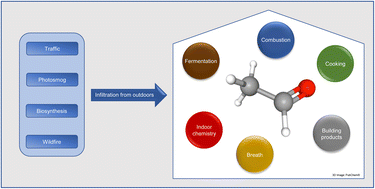
Environ. Sci.: Atmos., 2023,3, 474-493
https://doi.org/10.1039/D2EA00146B
Assessment of aldehyde contributions to PTR-MS m/z 69.07 in indoor air measurements
PTR m/z 69.07 commonly attributed to isoprene suffers interference from C5–C10 aldehydes indoors, especially when ozone is present. The contribution of nonanal could be quantified by using the protonated molecular ion, unlike the other aldehydes.

Environ. Sci.: Atmos., 2023,3, 1286-1295
https://doi.org/10.1039/D3EA00055A
The fate of organic peroxides indoors: quantifying humidity-dependent uptake on naturally soiled indoor window glass
The effect of humidity on organic hydroperoxide (ROOH) removal from air to real indoor surface films was investigated. A novel flow reactor for studying uptake kinetics of indoor pollutants on indoor materials is introduced.

Environ. Sci.: Processes Impacts, 2023,25, 1031-1048
https://doi.org/10.1039/D3EM00041A
Indoor and outdoor air quality impacts of cooking and cleaning emissions from a commercial kitchen
Online gas- and particle-phase measurements in a commercial kitchen reveal exposure risks and outdoor air impacts during cooking and cleaning.

Environ. Sci.: Processes Impacts, 2023,25, 964-979
https://doi.org/10.1039/D2EM00484D
Hydrogen peroxide emissions from surface cleaning in a single-family residence
High levels of reactive chemicals may be emitted to the indoor air during household surface cleaning, leading to poorer air quality and potential health hazards.
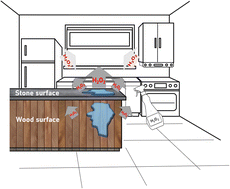
Environ. Sci.: Processes Impacts, 2023,25, 781-790
https://doi.org/10.1039/D2EM00434H
Modeling the fate and involuntary exposure to tetrahydrocannabinol emitted from indoor cannabis smoking
Second and third hand exposure to cannabis smoke is predicted to lead to THC concentrations exceeding impaired driving laws in adults and toddlers, but enhanced ventilation and particle filtration are effective mitigation measures.

Environ. Sci.: Atmos., 2023,3, 760-772
https://doi.org/10.1039/D2EA00155A
Emerging investigator series: an instrument to measure and speciate the total reactive nitrogen budget indoors: description and field measurements
A robust and quantitative instrument that measures total gas-phase reactive nitrogen (tNr) has been developed for indoor air quality surveys. It can focus on NOx, HONO, and NH3 levels indoors, from the complete tNr budget, on timescales of 5–20 min.
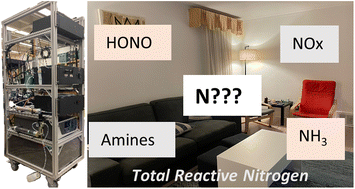
Environ. Sci.: Processes Impacts, 2023,25, 389-404
https://doi.org/10.1039/D2EM00446A
Indoor particulate matter (PM) from cooking in UK students' studio flats and associated intervention strategies: evaluation of cooking methods, PM concentrations and personal exposures using low-cost sensors
Domestic cooking is critical for release of particulate matter (PM) in indoor environments. This study tested low-cost sensors to assess PM from cooking in student studio flats for different cooking methods and to establish the impact of extractors.

Environ. Sci.: Atmos., 2023,3, 537-551
https://doi.org/10.1039/D2EA00171C
Investigation of indoor air quality in university residences using low-cost sensors
Indoor air quality (IAQ) is crucial for the wellbeing of university students. Yet, IAQ in student residences is highly variable and challenging to monitor. This work is the first to monitor IAQ in student residence with a low-cost sensor network.
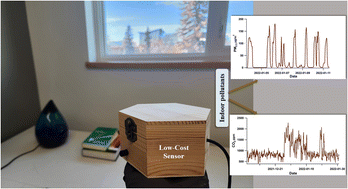
Environ. Sci.: Atmos., 2023,3, 347-362
https://doi.org/10.1039/D2EA00149G
Near-source hypochlorous acid emissions from indoor bleach cleaning
Cleaning surfaces with sodium hypochlorite (NaOCl) bleach can lead to high levels of gaseous chlorine (Cl2) and hypochlorous acid (HOCl); these have high oxidative capacities and are linked to respiratory issues.

Environ. Sci.: Processes Impacts, 2023,25, 56-65
https://doi.org/10.1039/D2EM00405D
Particulate matter in a lockdown home: evaluation, calibration, results and health risk from an IoT enabled low-cost sensor network for residential air quality monitoring
Low-cost sensor analysis of indoor air quality.

Environ. Sci.: Atmos., 2023,3, 65-84
https://doi.org/10.1039/D2EA00124A
Real-time measurements of product compounds formed through the reaction of ozone with breath exhaled VOCs
Human presence can affect indoor air quality because of secondary organic compounds formed upon reactions between gaseous oxidant species, e.g., ozone (O3), hydroxyl radicals (OH), and chemical compounds from skin, exhaled breath, hair and clothes.
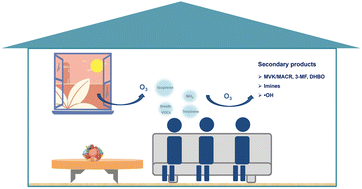
Environ. Sci.: Processes Impacts, 2022,24, 2237-2248
https://doi.org/10.1039/D2EM00339B
Partitioning of reactive oxygen species from indoor surfaces to indoor aerosols
Ozone chemistry taking place on indoor surfaces is predicted to increase inhalation exposure of reactive oxygen species in indoor aerosols.

Environ. Sci.: Processes Impacts, 2022,24, 2310-2323
https://doi.org/10.1039/D2EM00307D
Aerosol emissions and their volatility from heating different cooking oils at multiple temperatures
Heating cooking oils at high temperatures emits aerosols in the fine and ultrafine size ranges as well as a variety of volatile organic compounds that could have implications on both indoor as well as outdoor air quality.
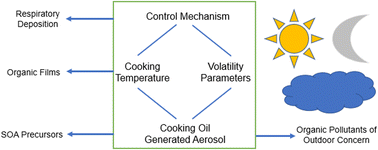
Environ. Sci.: Atmos., 2022,2, 1364-1375
https://doi.org/10.1039/D2EA00099G
About this collection
For this Environmental Science: Atmospheres and Environmental Science: Processes and Impacts collection we invited submissions that focus on all aspects relating to indoor air quality, including:
•Studies advancing the field of environmental sciences in surface chemistry, microbial activity, photochemistry, and exposure science.
•Studies using both theoretical and experimental methods.
•Various approaches including instrument development, measurements, modelling and consideration of policy and health impacts of indoor air quality.